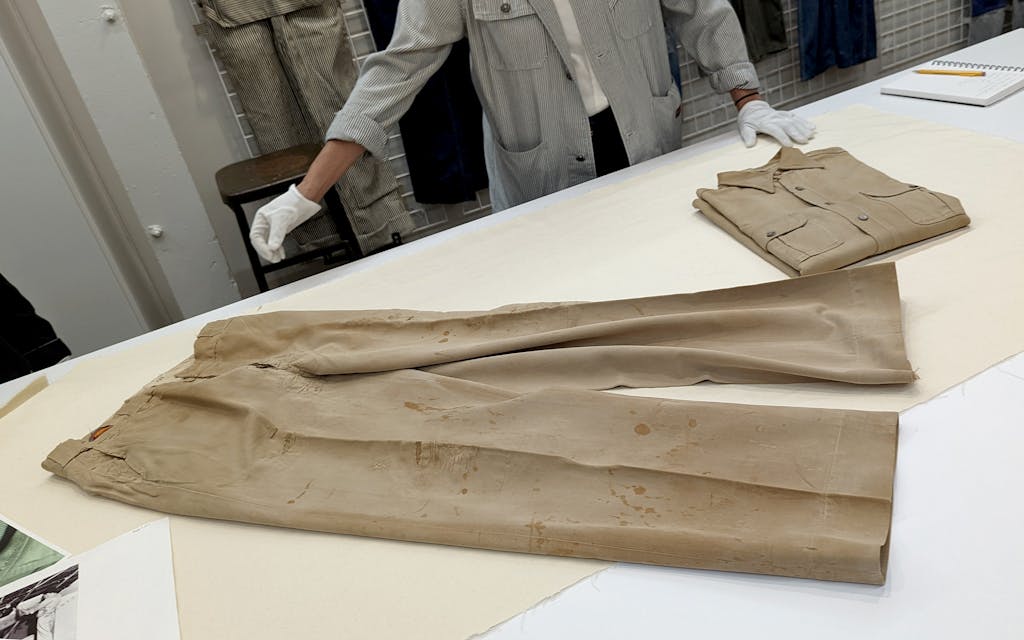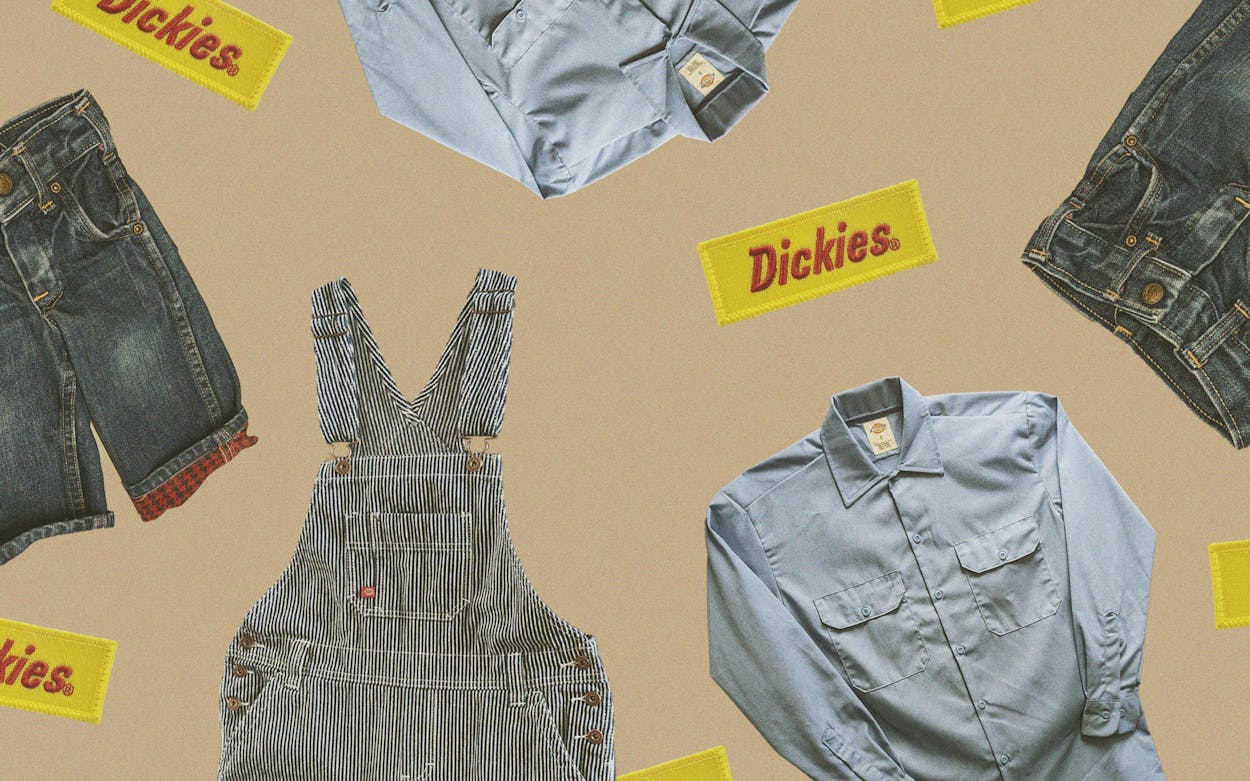In today’s fast-fashion culture, a mended jacket feels like an artifact from another time. I’m standing in a small storage room turned museum in Dickies’ Fort Worth headquarters, a humble brick building on West Vickery Boulevard on the city’s west side. On the surrounding walls hang overalls, leisure suits, and the errant pair of butterfly quilt–stitched trousers that look like they got lost on their way from a seventies disco.
But my eye continues to be drawn to the worn-out, beat-up, mended, and re-mended clothing that has found its way here. These items, more than the ones in pristine condition, seem to tell stories not only of their owners but of a hardscrabble work ethic born of the Dust Bowl and the Great Depression, and of this Texas apparel company itself, now celebrating one hundred years in business.
With its decidedly proletarian roots, Dickies has quietly (and unintentionally) threaded an unlikely alliance through the decades, attracting the loyalty of mechanics, college students, rappers like Ice Cube and Snoop Dogg, punks, Latino youth in West Texas, West Coast skateboarders, and international fashionistas—not to mention a whole lot of grandfathers. These diverse groups have embraced Dickies over the past century, perhaps drawn to the humble blank slate offered up by its nondescript polyester/cotton button-down shirts and work pants, with no trace of pretension in their design of clean lines and tiny red, blue, and yellow logo patches with the iconic horseshoe. At the Emmys in September, actor Pete Davidson appeared on stage dressed head to toe in the brand’s pieces. Gen Z TikTokers share viral “hauls” of Dickies Original 874 Work Pants (retail price: $29.99), waistbands folded over as is currently the style among that set, as if they were discovering the brand anew.
Ann Richardson unfurls a pair of 1920s-era Dickies denim trousers onto a tabletop, removing her preservation gloves for just a moment to allow her fingers to caress the fabric. “This feels so good—it’s a beautiful piece of fabric. I would say it’s a thirteen-and-a-half- or fourteen-ounce denim; it’s all cotton, three-by-one right-hand twill.” She takes a pause to sniff. “Doesn’t smell like indigo anymore—that’s too bad.”
Richardson has worked at Dickies for fifty years, half of the company’s history, starting as an assistant stylist and eventually becoming chief archivist, cataloging a century of fashion. Though Dickies continues to crank out workaday uniforms for the masses (in some cases, actual uniforms for schoolchildren and medical scrubs, in addition to its iconic overalls, trousers, and Eisenhower jackets), it’s also safe to say Dickies doesn’t quite make clothing the way it did in 1922.

Back then, founders and cousins E.E. “Colonel” Dickie and C.N. Williamson, plus Williamson’s son, C.D. Williamson, were launching a brand that stemmed from the former United States Overall Company of Texas. A 1920s photograph shows somber-looking white men all wearing button-down coats over ties and work apparel standing in front of that first building. A sign says, “Dickies Best Work Clothes – Play Suits”—a nod to the coexistence of “work” and “play” that would influence the company’s designs for the next century.
Colonel Dickie was so resolute in the quality of the company’s products that he created a satisfaction guarantee. “These overalls must make good, or I will,” he said. The guarantee still stands, though gone are the days of the kind of fabrics that could withstand decades of hard labor and the stitches that were sewn by women working right here in Fort Worth. (Like most major apparel brands, Dickies’ manufacturing operations have largely moved outside of the country in recent decades). Gone too are the days of people carefully placing patches onto worn elbows and knees following that World War II–era credo, “Use it up, wear it out, make it do, or do without.”
But regardless of the ways Dickies has changed over the years, the brand has staying power. It has found a home within major social movements over time, particularly among youth seeking solidarity in the midst of unrest. The baggy monochromatic zoot suit favored throughout African American and Latino communities in the U.S. during the 1930s and ’40s drew race-based criticism from whites. By the time of the war, critics were saying the suits were “wasteful” of fabric and unpatriotic during a time of austerity. Zoot suits became an identifier for racial harassment and brutality against Latinos by police and servicemen, particularly on the West Coast, leading to the so-called “zoot suit riots” in summer 1943. Eventually the garments would be banned by law in Los Angeles, inducing young Latinos to turn to Dickies as an alternative, said senior designer Corinna Wright. Dickies offered sharp creases and a polished look reminiscent of the zoot suit. In later decades, these communities reimagined the brand as a symbol of cultural pride.
“We all grew up with Dickies one way or another,” says Austin-based hairstylist Brianna Lujan, who was raised in El Paso. “It was affordable and accessible to us. Always wrinkle-free with a hard iron crease in the front was big for cholos, sometimes a little more baggy with a belt, a white baggy T-shirt, or a nice oversized three-button polo. And for women, you accessorized it with some gold layered necklaces.”
The brand has always walked a fine line, honoring its workwear roots while acknowledging the myriad fans in other, not strictly blue-collar, sectors. “It’s the daily challenge, right? You certainly could overextend, catering one way and alienating the other way,” says Dickies’ global chief marketing officer, Sarah Crockett. “How we’ve gotten here today one hundred years later is staying true to who we are. It’s the welcome mat to appropriation. We welcome that [appropriation], we encourage it, and we love watching it.”
Originally from Oklahoma, Ann Richardson, the long-tenured Dickies employee who would go on to be a director of trend development, graduated from Texas Christian University with a merchandising degree and responded to a newspaper help-wanted ad by Dickies in 1972. She places the first “appropriation moment” as sometime in the 1980s, when the company started receiving word from salesmen in the northeastern U.S. that college girls were wearing men’s work pants. “We were like, ‘What? They’re doing what?’” she says. Dickies responded to the new demand by manufacturing a new line of rainbow-hued pants, with great success. Richardson remembers walking into meetings with New England salesmen during the time following the launch and feeling like a rock star. “You would’ve thought I was Christian Dior,” she says.
In 1988, the group N.W.A. released Straight Outta Compton, with Dr. Dre drenched in Dickies apparel in the music video for “Express Yourself.” The video cemented Dickies’ cultural significance in rap for the next several decades, with brand devotees including Snoop Dogg taking up the mantle in the 1990s. Despite working closely with Dickies’ top brass at the time, Richardson doesn’t recall conversations about these new Dickies’ standard-bearers. Historical advertisements show that the company did not court these audiences in its advertising the same way it did with the college students.
In 2017, Dickies was bought by Denver-based apparel company VF Corp., whose portfolio also includes brands the North Face, Timberland, and Vans. Two years later, the 14,000-seat Dickies Arena opened two miles northeast of the Fort Worth headquarters. Over in Dallas, Big Tex is freshly attired in a Dickies shirt for this year’s State Fair of Texas. Dickies’ PR execs speak excitedly about new collaborations with artists and designers planned for coming years (recent collaborators include Brain Dead and New York Sunshine, the latter preceded by a 2021 art installation that featured a house made of Dickies blue twill fabric in Marfa). The company maintains its historic headquarters building on Fort Worth’s West Vickery Boulevard, where Richardson and Wright are working on the archive project, but most company employees are scattered throughout the U.S. Still, it’s in Fort Worth that you can see the roots of the company’s legacy—and attend a rodeo at Dickies Arena.
In addition to helping with Dickies’ historical preservation and archival efforts, Richardson serves as general manager of the company’s 1922 line, a U.S.-made heritage collection. The new clothes re-create some of those oldie-but-goodie brand throwbacks—the Indigo Chore Coat, the Gas Station Twill Jacket, Double Knee Pants, the Selvedge Denim Jeans—using high-end fabrics and vintage design details. The pieces are produced in limited quantities and retail for upward of $200.
Although she has witnessed the company’s rise for a half century, one of the things that most excites Richardson is lingering over a battered, older-vintage pair of pants or a button-down shirt that has been patched and re-patched until it hardly resembles its original design.
For years, Dickies fans have mailed their old clothing into the company hoping to cash in on the guarantee—including one particularly beloved note that came tucked into the pocket of a 1933 work shirt belonging to a man in Amarillo. “Dear Sirs,” the note reads, “I am sending you a khaki suit bought 1933 from Gums Dry Co. Turkey Tex. They have gone out of business. I wear Dickies clothes all the time. I think this will be a good advertisement for you. Hope you may send me a new suit in the place of it.” Richardson assumes they did.
“During that time in Amarillo, you’ve got Dust Bowl, Depression, World War II,” Richardson says, noting the formerly long-sleeved shirt that had been cut and sewn into a short-sleeve version. “Here’s where the shirt really wore out—they removed the collar, turned it around and reattached it. No pleats in the back of this shirt, so he’s not getting any breaks, and it’s a slim fit too. He’s a grown man, and he’s a size twenty-eight pants, because people didn’t have extra food back then. If you were a West Texas farm kid, life could be kind of tough.”
She marvels at the careful repair work before folding the garment and tucking it back into an archival drawer. It’s the opposite of flashy, a far cry from couture. It really does seem to be a good advertisement, after all.
- More About:
- Style & Design
- Fashion
- Fort Worth






